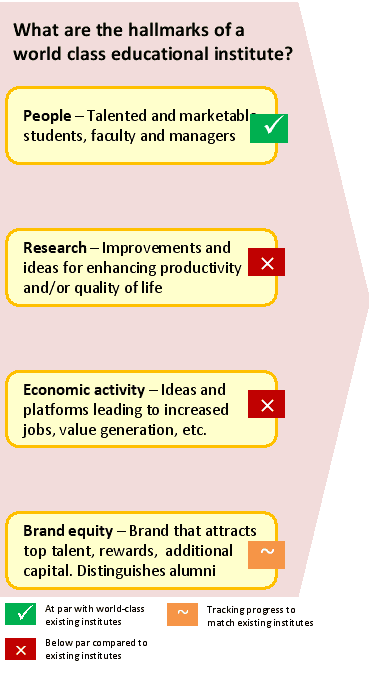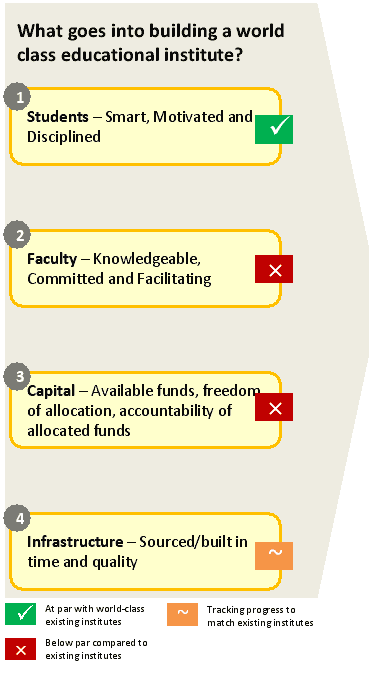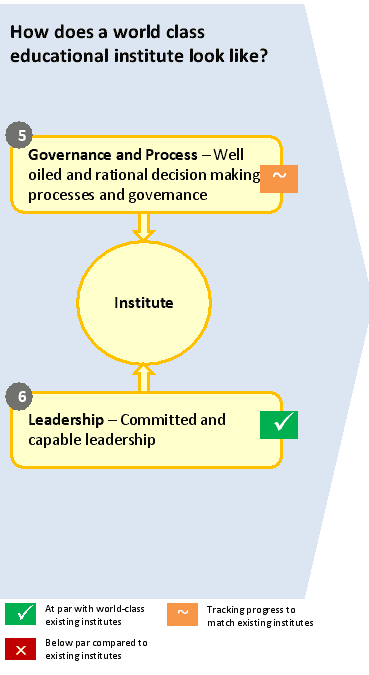
We recently invited you to share your opinion on Jairam Ramesh's recent statements about the quality of IIT and IIM faculty. In response, Karan Singal, an alumnus of IIT and IIM, tells us what it takes to be a world-class institute and how we can make our elite educational institutions at par with international universities.
Environment minister Jairam Ramesh recently made the comment that the faculty at nation's premier institutes is not world class because they don't produce good quality research.
He also mentioned that the students are world class. It created a lot of debate in public and political circles. I believe the topic merits some attention.
Looking at the broader picture first, a better understanding of the term world-class institute is required.
What it means to be a world-class institute
A truly world class institute in my view would have excellent outputs coming out of it in terms of
A lot goes into delivery of these outputs, for instance:
A full view of the various elements can be seen in the tables that go alongside with this article. Read on to find out more!

Students There is absolutely no doubt that students in India's potential world class institutes including IITs, IIMs, National Law Schools, premier medical institutes, etc are smart and hard-working.
India's got talent and this talent is also rewarded with high package offers post their graduations.
They are also able to secure positions for higher education in foreign world-class institutes at will.
In the famous episode of '60 minutes' series by CNN, the students from IIT were considered at par with their counterparts in MIT, Boston.
The programme even went on to say that candidates underwent a more rigorous competition for entrance at undergraduates than any other institute.
It does not come as a surprise that a lot of IITians have made us proud.
People affiliated to non-engineering branches are also in reckoning for example Prof Tej P Singh from AIIMs, an eminent biophysicist who has made original and novel contributions to the structural studies of proteins. But there is one area that is missing in their cap --discipline for excellence.
Students in our institutes are focused on short-term objectives e.g. getting good grades, jobs and resume points for future use.
There is limited appetite to master the subjects taught and becoming subject matter experts.
The percentage of students graduating from IIMs and entering into entrepreneurship is also in lower single digits.
What's working: Smart, hard-working students
What needs to improve: Discipline for excellence in their respective fields
Faculty These have been the centre of debate although they should not be looked as the scapegoat of all issues with Indian institutes attaining world-class status.
The fact they are inside the system for a long term does increase their role but let us not forget that it is more than the faculty which merit a "change".
There are some genuinely good faculty in our institutes. Prof Ashok Jhunjhunwala, professor in Department of Electrical Engineering in IIT Madras is a great mentor and facilitator.
He has worked with industry to setup TeNet group, which incubates technology companies year after year.
Dr Amartya Sen, noble laureate, taught economics in Delhi School of Economics from 1961 to 1972. However, there is a less lustrous side of the tale.
Most of the faculty in our institutes are not known for notable research at the international level.
They have done their share of publishing research papers, books and articles but the truly remarkable masterpieces have been few and scattered.
There are many factors at play here including student-faculty ratio which translates into more lecture hours for faculty vs research hours, availability of funds for blockbuster research and commitment of students at all levels to meaningfully engage in developing research.
What's working: Theoretical knowledge
What needs to improve: Practical knowledge, incentives for high quality research, attraction of more faculty to reduce burden from non-research activities
Capital It is common knowledge that most of the premier institutes in India are government run and are given funds collected from the taxpayers to conduct their activities.
There is no real evidence of any manhandling of the finances by the institute machinery, so that is a breather.
The institutes make sure they keep their finances in order and run a tight ship.
What is missing is the required accountability to keep track of these investments.
There seem to be rudimentary KPIs (Key Performance Indicators) within the government to assess the return on these funds.
For example, the institutes and the government do not openly promote use of desirable KPIs like 'number of breakthrough researches / annual funding', '# successful ventures launched per year'.
There seems to be a void in such comparisons in the printed media. There are limited surveys for "% of students who choose entrepreneurship vs % of students who would like to choose entrepreneurship pre-education."
The purpose of these educational institutes is to promote dreams not to replace them with risk-averse choices of stable jobs.
What's working: Availability of funds
What needs to improve: Freedom to allocate funds, accountability of allocated funds
Infrastructure Now, infrastructure includes both fixed assets like land, building, equipment, etc. and current assets like supplies for books, experiment material, stationery, etc.
At the moment, the infrastructure in our institutes is a mixed bag.
The long dated existing institutes have decent infrastructure whereby the facilities staff and construction form a well-running machinery.
The newer institutes boast of a state-of-the-art setup with well-supplied labs, academic blocks, libraries, etc.
What is lagging is the ability of these institutes to get things done in both time and quality. The fixed asset development of the newer institutes can over-run by 2-5 years.
The procurement of small items like new software, subscriptions to new journals can be a painful process with limited paperless commissioning.
There is a series of approvals built into their systems and mostly paper based making the whole process slower.
The delay in building academic blocks, laboratories is never really questioned by the students or the public who are the most impacted parties in the process.
What's working: Buildings, Libraries, Technology Infrastructure
What needs to improve: Procurement of material, software, etc.

Governance and Processes A well-governed and efficient process organisation can outrun long established peers in a matter of few years.
Take the example of Indian School of Business (ISB). It started quite late as compared to some of the well established IIMs but caught up very quickly despite the initial perception.
It was believed since ISB has higher fees, most of the brighter students would prefer IIMs over ISB.
Moreover ISB had a curriculum of only 1 year vs IIMs with 2 years.
ISB took a very radical approach of attracting students with higher work-experience, building very strong international business school tie-ups and leveraged the contacts by its senior leadership like Sumantra Ghoshal to quickly ramp up faculty to deliver a great offering.
None of the success would have been possible without the invisible emphasis on strong decision-making processes, infrastructure delivery, and allocating capital to the initiatives. An incentive based system is much more likely to self-govern as compared to a non-incentive based setup.
It is high time we set aspiring targets for our premier institutes as milestones to become world class.
What's working: Alignment of stakeholders in decision-making
What needs to improve: Goal setting, tracking and monitoring, distribution of power for decision-making and formal positive and negative incentives for performance.
Leadership The story of Sumantra Ghoshal is not the only successful leadership story. Prof Prakash Chandra, the current director at IIM Bangalore is also a leader who leads from the front.
He set himself the task of enhancing IIM Bangalore's international image by focusing of visibility of the IIM-B brand across the globe.
Suddenly under his leadership beginning a few years ago, IIM-B started reaching out to its alumni more effectively, deepening exchange programmes with premier institutes around the globe, getting awards and recognition for its standing in South East Asia.
He also helped found the Centre for Innovation, Incubation and Entrepreneurship at IIM-A and was the Chairperson of the Centre.
We do have great leaders in our institutes but we need more. We need charismatic and aspiring leaders who are unfazed by continued hurdles like government interference, process inefficiency and the like.
A stable head at the top can be the shot in the arm that many of our potential world-class institutes need.
What's working: Astute, hard working leaders
What needs to improve: Aspiring, charismatic personalities
The author is an alumnus of IIT (class of 2004) and IIM (class of 2008)